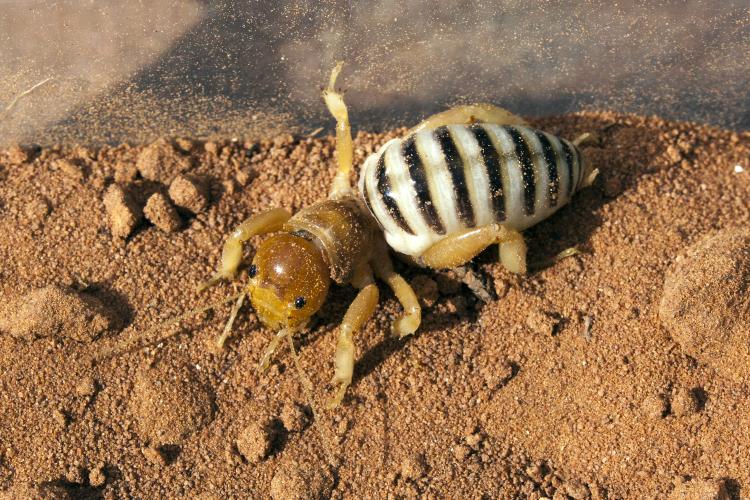A startling creature in the sand
The Jerusalem cricket illustrating this column was a gift from Akasha Faist, a postdoctoral fellow in my department, working on restoration ecology.
She had been sifting a large number of soil samples, which is mind-numbingly tedious work, when she was startled by an inch-long, brightly colored insect that popped up and scrambled energetically in the sand. She had not seen a Jerusalem cricket before, and neither had I.
Jerusalem crickets are not crickets and do not occur in Jerusalem, so how did this common name come about?
Very few people have seen them, and they are large and brightly colored, so I think it is the startle factor. Apparently, about the time this common name was adopted, the words "Jerusalem" and "cricket" were both epithets — the sorts of words uttered emphatically and involuntarily when startled.
Jerusalem crickets are common, but few people have seen them because they are subterranean, nocturnal and silent. Click here or on photo to see larger image. Photo by Jeff Mitton
Today, we use four letter words.
The soil sample had been taken from pinõn-juniper woodland near the Utah/Colorado border, so this species is probably Stenopelmatus fuscus. I say probably because we are just now learning that morphology is inadequate to identify Jerusalem cricket species.
Currently we recognize 29 species of Jerusalem crickets. But from other insects we expect each species to have a unique song, and unique songs are numerous — perhaps as many as 180. Several unique songs commonly occur within a recognized species, without any variation in size, morphology, color or pattern.
The description of this species warns that it might be a species group rather than a single species. This uncertainty will be resolved by molecular systematists working with behavioral biologists who analyze songs.
Crickets have songs, but Jerusalem crickets' "songs" are probably inaudible to us, for they are a drumming produced by the insect beating its abdomen on the ground. Other Jerusalem crickets detect the vibrations in the sand with subgenal organs on all six feet.
One could be sitting by a campfire at night in the desert, surrounded by a horde of lusty Jerusalem crickets drumming desperately, and never hear or see a thing.
Jerusalem crickets have a rounded head, a bulbous abdomen and spiny legs. The front legs are large and powerful, developed primarily for digging. They generally live in sandy soil, and forage underground in the day, eating roots, tubers and decaying plant material. They often forage on the surface at night, particularly after rain, taking live insects and dead plant and animal material.
Because they eat roots and tubers, they have large, powerful mouthparts. So give some thought to picking up a Jerusalem cricket. Some people keep them as pets and have no problems, but if they are handled roughly or are threatened, they can draw blood with a pinching bite.
The majority of the life cycle is spent underground. Females lay eggs in the sand, and young larvae burrow through the sand searching for food. Older larvae and adults forage above ground at night, but sporadically.
Jerusalem crickets become mature at an age of 1.5 years and live 2 to 6 months as adults, searching for mates, mating and depositing eggs in the sand.
Mating of Jerusalem crickets is a matter of contorting and lining up body parts in such a precise way that mating attempts are not always fruitful. It generally works if a male is the same size as the female, but if the male is only ¼ inch longer than the female, the probability of successful copulation drops to 50 percent, and it decreases even more as his size exceeds hers.
It works best of all when the male is smaller than the female. Mating success of males declines with size, so sexual selection favors small males. And because large females lay more eggs than small females, sexual selection favors large females.
Consequently, in Jerusalem crickets, size matters and males are considerably smaller than females.


